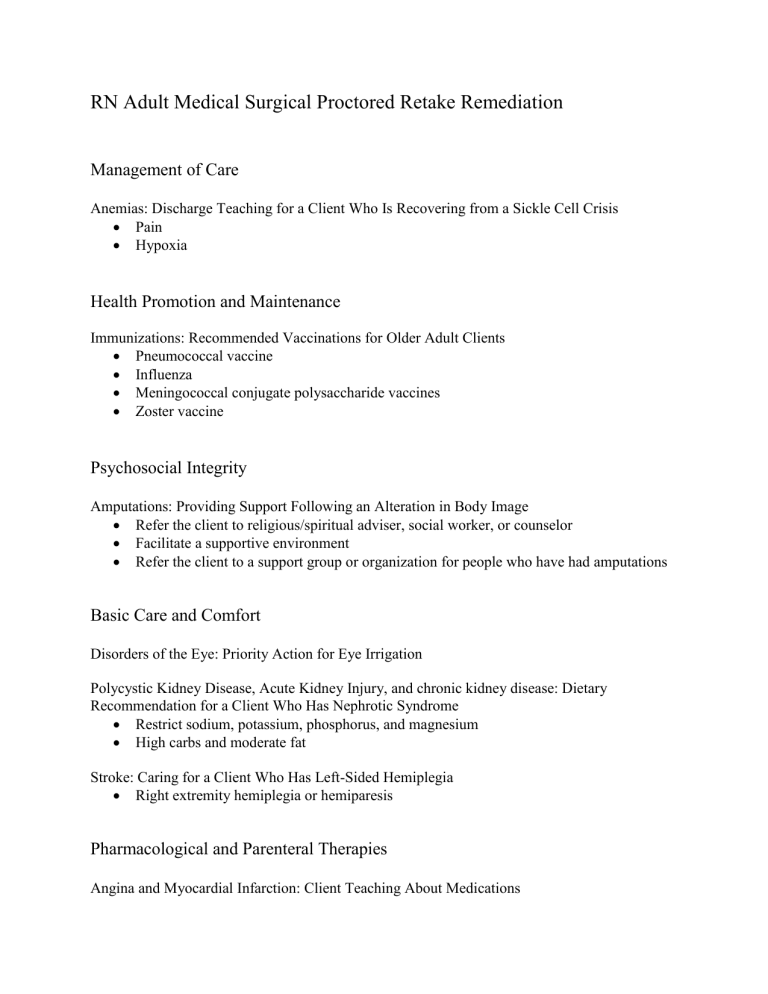
RN Adult Medical Surgical Proctored Retake Remediation Management of Care Anemias: Discharge Teaching for a Client Who Is Recovering from a Sickle Cell Crisis Pain Hypoxia Health Promotion and Maintenance Immunizations: Recommended Vaccinations for Older Adult Clients Pneumococcal vaccine Influenza Meningococcal conjugate polysaccharide vaccines Zoster vaccine Psychosocial Integrity Amputations: Providing Support Following an Alteration in Body Image Refer the client to religious/spiritual adviser, social worker, or counselor Facilitate a supportive environment Refer the client to a support group or organization for people who have had amputations Basic Care and Comfort Disorders of the Eye: Priority Action for Eye Irrigation Polycystic Kidney Disease, Acute Kidney Injury, and chronic kidney disease: Dietary Recommendation for a Client Who Has Nephrotic Syndrome Restrict sodium, potassium, phosphorus, and magnesium High carbs and moderate fat Stroke: Caring for a Client Who Has Left-Sided Hemiplegia Right extremity hemiplegia or hemiparesis Pharmacological and Parenteral Therapies Angina and Myocardial Infarction: Client Teaching About Medications Place under the tongue to dissolve Two more additional doses can be taken at 5-minute intervals Angina and Myocardial Infarction: Reinforcing Teaching About Nitroglycerin Place under the tongue to dissolve Two more additional doses can be taken at 5-minute intervals Blood and Blood Product Transfusions: Preparing to Administer a Blood Transfusion Large bore access 18 g or 20g Obtain blood products form the blood bank Two RNs double check the blood match Prime with NS in Y-tubing with a filter Begin within 30 minutes of obtaining blood Blood and Blood Product Transfusions: Steps to Administer a Blood Transfusion Explain the procedure Assess vitals Remain for the first 15-30 min Review labs to ensure client needs transfusion Verify prescription Obtain consent Assess for past transfusion reactions Electrolyte Imbalances: Manifestations of Hypokalemia Respiratory failure Cardiac arrest Osteoarthritis and Low-Back Pain: Planning Pain Relief for a Client Who Has Osteoarthritis Heat Cold (20 minutes) Maintain joints in functional position Tuberculosis: Adverse Effects of Antimicrobial Therapy Nausea Vomiting Diarrhea Abdominal pain Loss of appetite Bloating Reduction of Risk Potential Neurologic Diagnostic Procedures: Determining a Glasgow Coma Scale Score Eye opening o 4 = eye opening occurs spontaneously o 3 = eye opening occurs secondary to sound o 2 = eye opening occurs secondary to pain o 1 = eye opening does not occur Verbal o 5 = conversation is coherent and oriented o 4 = conversation is incoherent and disoriented o 3 = words are spoken, but inappropriately o 2 = sounds are made, but no words o 1 = vocalization does not occur Motor o 6 = commands are followed o 5 = local reaction to pain occurs o 4 = general withdrawal from pain o 3 = decorticate posture (adduction of arms, flexion of elbows and wrists) is present o 2 = decerebrate posture (abduction of arms, extension of elbows and wrists) is present o 1 = motor response does not occur Pancreatitis: Expected Laboratory Findings Blood amylase increased Blood lipase increased Urine amylase increased WBC increased Platelets decreased Calcium & Magnesium decreased Liver enzymes & bilirubin increased Serum glucose increased ESR elevated Polycystic Kidney Disease, Acute Kidney Injury, and chronic kidney disease: Laboratory Findings Creatinine increases BUN increases Urine specific gravity increases Sodium can increase or decrease Hematocrit decreases Metabolic acidosis Postoperative Nursing Care: Assessment of Postoperative Dressing Report excess drainage Outline drainage spots with a pen noting date and time Physiological Adaptation Airway Management: Evaluating Client Understanding of Tracheostomy Care Use surgical asepsis to remove and clean inner cannula Clean stoma site Replace ties if soiled or wet Fresh dressing







